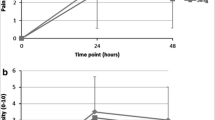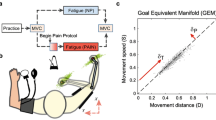Abstract
Purpose
The goal of complex tasks can be maintained despite variability in the movements of the multiple body segments involved in the task (VARelements). This variability increases in acute pain and may enable the nervous system to search for less painful/injurious movement options. It is unclear whether VARelements increases when pain challenges simple tasks with fewer movement options, yet maintain successful attainment of the goal. We hypothesised that during acute pain related to a simple movement: (1) the task goal would be maintained; (2) VARelements would be increased; and (3) if VARelements increased during pain, it would decrease over time.
Methods
Movements of the right wrist/forearm were recorded with a three-dimensional motion analysis system and during a repetitive radial-ulnar deviation task between two target angle ranges (the task goal). We measured success of attaining the goal (repetitions that reached the target range and total absolute error in degrees), and variability in the motion of wrist flexion–extension and forearm pronation–supination (VARelements). Fourteen healthy participants performed the task in one session before, during, and after wrist extensor muscle pain induced with hypertonic saline, and in another session without pain.
Results
The task goal was maintained during acute pain. However, VARelements in other motion planes either reduced (pronation–supination) or did not change (flexion–extension). Thus, variability of task elements is constrained, rather than increased, in simple tasks.
Conclusions
These data suggest the nervous system adapts simple tasks with limited degrees of freedom by reduction of VARelements rather than the increase observed for more complex tasks.





Similar content being viewed by others
References
Boudreau S, Romaniello A, Wang K, Svensson P, Sessle BJ, Arendt-Nielsen L (2007) The effects of intra-oral pain on motor cortex neuroplasticity associated with short-term novel tongue-protrusion training in humans. Pain 13:169–178
Brumagne S, Cordo P, Verschueren S (2004) Proprioceptive weighting changes in persons with low back pain and elderly persons during upright standing. Neurosci Lett 366:63–66
Dingwell JB, Cusumano JP, Cavanagh PR, Sternad D (2001) Local dynamic stability versus kinematic variability of continuous overground and treadmill walking. J Biomech Eng 123:27–32
Fedorowich L, Emery K, Gervasi B, Côté J (2013) Gender differences in neck/shoulder muscular patterns in response to repetitive motion induced fatigue. J Electromyogr Kinesiol. 23:1183–1189
Hamill J, van Emmerik REA, Heiderscheit BC, Li L (1999) A dynamical systems approach to lower extremity running injuries. Clin Biomech 14:297–308
Heiderscheit BC (2000) Locomotion variability and joint pain. Dissertation, University of Massachusetts
Heiderscheit BC, Hamill J, Van Emmerik REA (2002) Variability of stride characteristics and joint coordination among individuals with unilateral patellofemoral pain. J Appl Biomech 18:110–121
Hodges PW, Tucker KJ (2010) Moving differently in pain: a new theory to explain the adaptation to pain. Pain 152:S90–S98
Hodges PW, Moseley GL, Gabrielsson A, Gandevia SC (2003) Experimental muscle pain changes feedforward postural responses of the trunk muscles. Exp Brain Res 151:262–271
Ingham D, Tucker KJ, Tsao H, Hodges PW (2011) The effect of pain on training-induced plasticity of the corticomotor system. Eur J Pain 15:1028–1034
Latash ML (2012) The bliss (not the problem) of motor abundance (not redundancy). Exp Brain Res 217:1–5
Madeleine P, Mathiassen SE, Arendt-Nielsen L (2008) Changes in the degree of motor variability associated with experimental and chronic neck-shoulder pain during a standardised repetitive arm movement. Exp Brain Res 185:689–698
Malmström E-M, Westergren H, Fransson P-A, Karlberg M, Magnusson M (2013) Experimentally induced deep cervical muscle pain distorts head on trunk orientation. Eur J Appl Physiol 113:2487–2499
Mok NW, Brauer SG, Hodges PW (2007) Failure to use movement in postural strategies leads to increased spinal displacement in low back pain. Spine 32:E537–E543
Moseley GL, Hodges PW (2006) Reduced variability of postural strategy prevents normalization of motor changes induced by back pain: a risk factor for chronic trouble? Behav Neurosci 120:474–476
Murray GM, Peck CC (2007) Orofacial pain and jaw muscle activity: a new model. J Orofac Pain 21:263–278
Peters BT, Haddad JM, Heiderscheit BC, Van Emmerik REA, Hamill J (2003) Issues and limitations in the use and interpretation of continuous relative phase. J Biomech 36:271–274
Preatoni E, Ferrario M, Dona G, Hamill J, Rodano R (2010) Motor variability in sports: a non-linear analysis of race walking. J Sports Sci 28:1327–1336
Riley MA, Turvey MT (2002) Variability and determinism in motor behavior. J Motor Behav 34:99–125
Salomoni SE, Graven-Nielsen T (2012) Experimental muscle pain increases normalized variability of multidirectional forces during isometric contractions. Eur J Appl Physiol 112:3607–3617
Salomoni SE, Ejaz A, Laursen AC, Graven-Nielsen T (2013) Variability of three-dimensional forces increase during experimental knee pain. Eur J Appl Physiol 113:567–575
Scholz JP, Schöner G (1999) The uncontrolled manifold concept: identifying control variables for a functional task. Exp Brain Res 126:289–306
Singh T, Varadhan SKM, Zatsiorsky VM, Latash ML (2010) Adaptive increase in force variance during fatigue in tasks with low redundancy. Neurosci Lett 485:204–207
Slater H, Arendt-Nielsen L, Wright A, Graven-Nielsen T (2003) Experimental deep tissue pain in wrist extensors—a model of lateral epicondylalgia. Eur J Pain 7:277–288
Srinivasan D, Mathiassen SE (2012) Motor variability in occupational health and performance. Clin Biomech 27:979–993
Standring S (ed) (2005) Gray’s anatomy: the anatomical basis of clinical practice, 39th edn. Elsevier Churchill Livingstone, Edinburgh
Svendsen JH, Madeleine P (2010) Amount and structure of force variability during short, ramp and sustained contractions in males and females. Hum Mov Sci 29:35–47
Tsao H, Tucker KJ, Coppieters MW, Hodges PW (2010) Experimentally-induced low back pain from hypertonic saline injections into lumbar interspinous ligament and erector spinae muscle. Pain 150:167–172
Acknowledgments
The study was funded by a Program Grant (ID631639) and Research Fellowships (PH: APP1002190 and KT) from the National Health and Medical Research Council (NHMRC) of Australia.
Conflict of interest
The authors declare that they have no conflict of interest.
Ethical standards
The experiments comply with the current laws of Australia. All procedures were approved by the University of Queensland Medical Research Ethics Committee and conformed to the Declaration of Helsinki.
Author information
Authors and Affiliations
Corresponding author
Additional information
Communicated by Fausto Baldissera.
Rights and permissions
About this article
Cite this article
Bergin, M.J.G., Tucker, K.J., Vicenzino, B. et al. Does movement variability increase or decrease when a simple wrist task is performed during acute wrist extensor muscle pain?. Eur J Appl Physiol 114, 385–393 (2014). https://doi.org/10.1007/s00421-013-2777-6
Received:
Accepted:
Published:
Issue Date:
DOI: https://doi.org/10.1007/s00421-013-2777-6




